15 LinkedIn Best Practices That Will Help Your Business Page Grow
Discover 15 data-backed LinkedIn best practices that will help you improve your strategy and grow your brand on LinkedIn faster than before.

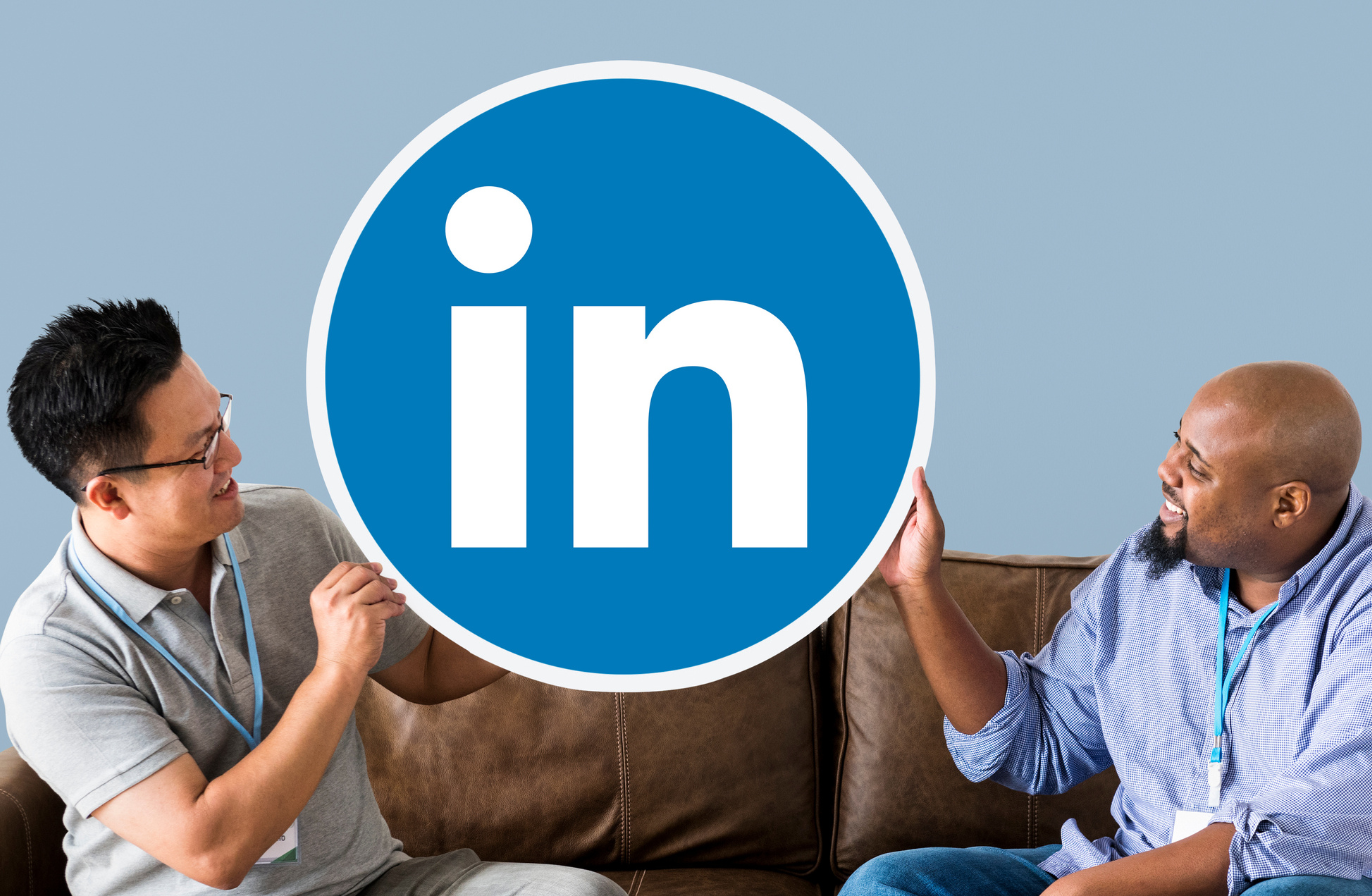
Forget recycled posts and polite applause.
To win at LinkedIn marketing, you need strategy, not spam.
This guide spills the LinkedIn best practices that slice through the noise—and level up your social media marketing like a pro.
Let’s get into it.
Best practices for an effective LinkedIn marketing strategy
Start learning how to optimize your LinkedIn posting strategy and discover the LinkedIn best practices for company pages that actually make an impact.
#1. Leverage thought leadership content
One of the best practices for LinkedIn in the B2B space is to leverage thought leadership content that sparks conversation, builds credibility, and earns trust.
Rather than hard-selling, brands should aim to educate, inspire, or challenge their audience with fresh perspectives from internal experts or industry voices.
As Marketing Expert Egline Samoei mentions, you can do that through consistent, authentic video content—whether short-form or long-form—that delivers real value to your audience.
In 2025, B2B brands can increase their brand presence by focusing more on thought leadership content. This can be through video content whether short vertical video content or long video content. While at it brands need to be consistent, be authentic and focus on content that is engaging and adds value.

By showing up consistently with valuable insights—whether through videos, articles, or carousel posts—your brand becomes not just a product or service, but a go-to resource in the industry.
#2. Encourage employees to become brand ambassadors
If you're serious about learning how to effectively use LinkedIn for marketing, start by looking inward.
Your employees are already one of your most valuable distribution channels.
When team members actively engage on LinkedIn, they humanize your brand, build trust, and drive reach far beyond what your company page can do on its own.
And interestingly enough, employee generated content tends to outperform branded posts because it feels more authentic and less promotional.
Think: a designer sharing early sketches of a new product, a marketer reflecting on campaign results, or a customer success lead spotlighting a great client moment.
These posts naturally reinforce your positioning while showcasing the real people behind the work.
To make this scalable, provide guidance without over-scripting.
Offer content toolkits, post prompts, or curated internal stories they can riff off of.
Recognize and reshare strong examples to create momentum.
Brand advocacy isn’t about asking employees to push corporate messaging — it’s about giving them the tools and autonomy to share meaningful perspectives that ladder up to your company’s narrative.
Remember that employees with strong personal brands are an asset and not a liability. Allow them to be advocates for your brand in a way that is honest, human, and authentic. Don't simply give them canned corporate language to cut and paste on LinkedIn, but allow them to share their honest thoughts and insights into your industry. — Jon-Stephen Stansel, Social Media Consultant
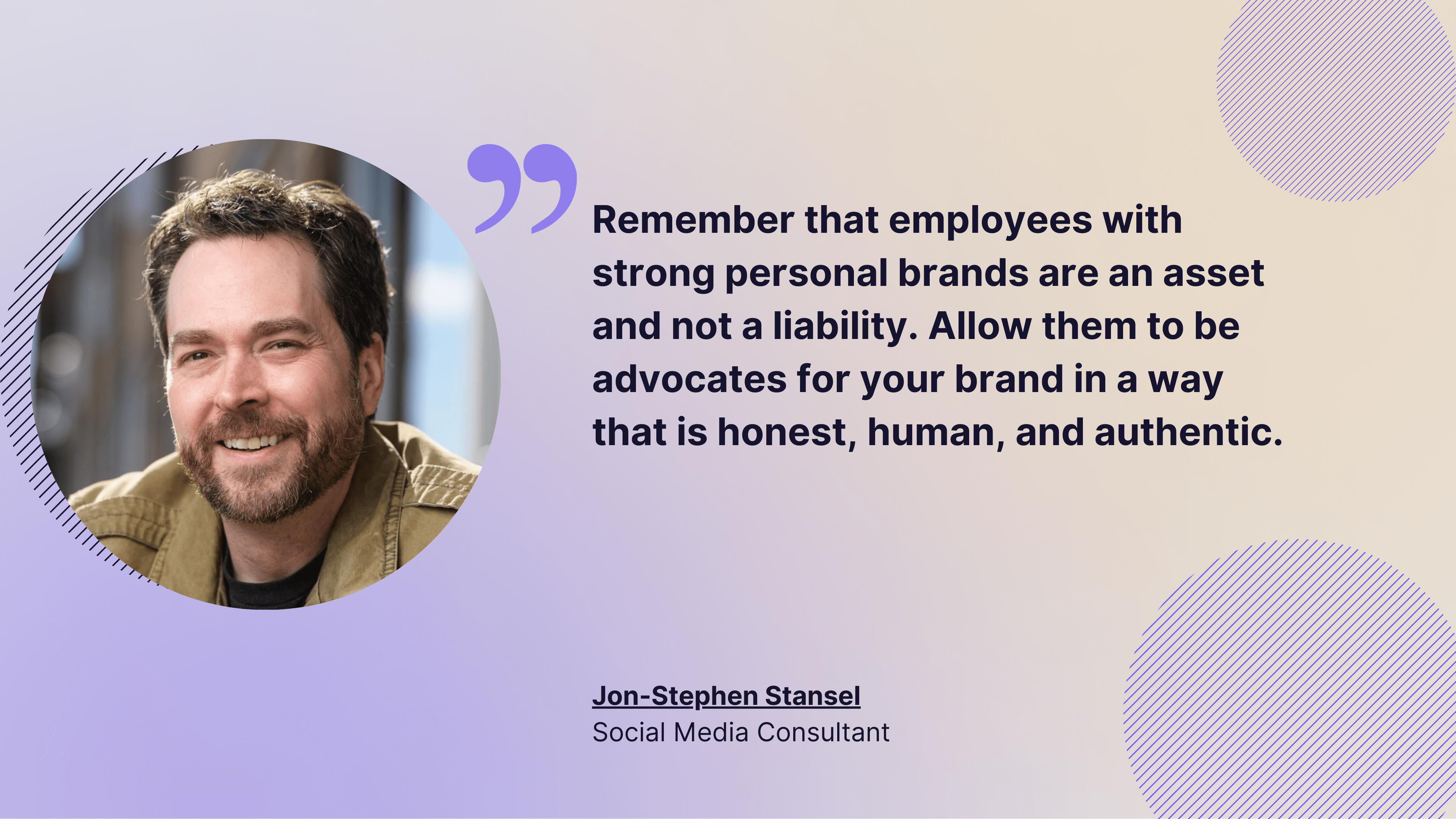
When done right, employee-generated content doesn’t just support your marketing — it is your marketing.
#3. Show your human side
In B2B vs B2C marketing, the strategies might differ, but one thing’s for sure: the future of social media lies in human connection.
Yes, even in the B2B world, people want to engage with people—not logos or stiff corporate jargon.
Sharing behind-the-scenes moments, employee spotlights, team wins, or even lessons learned from failures makes your brand more relatable and trustworthy.
Increasing your brand presence in 2025 on Linkedin will come down to having a more authentic, human approach to using the platform. Sharing stories and experiences rather than faceless graphics, stats and conference updates and creating deeper and more genuine connections with your audience. — Katie Brown, Founder @ Hive Social UK
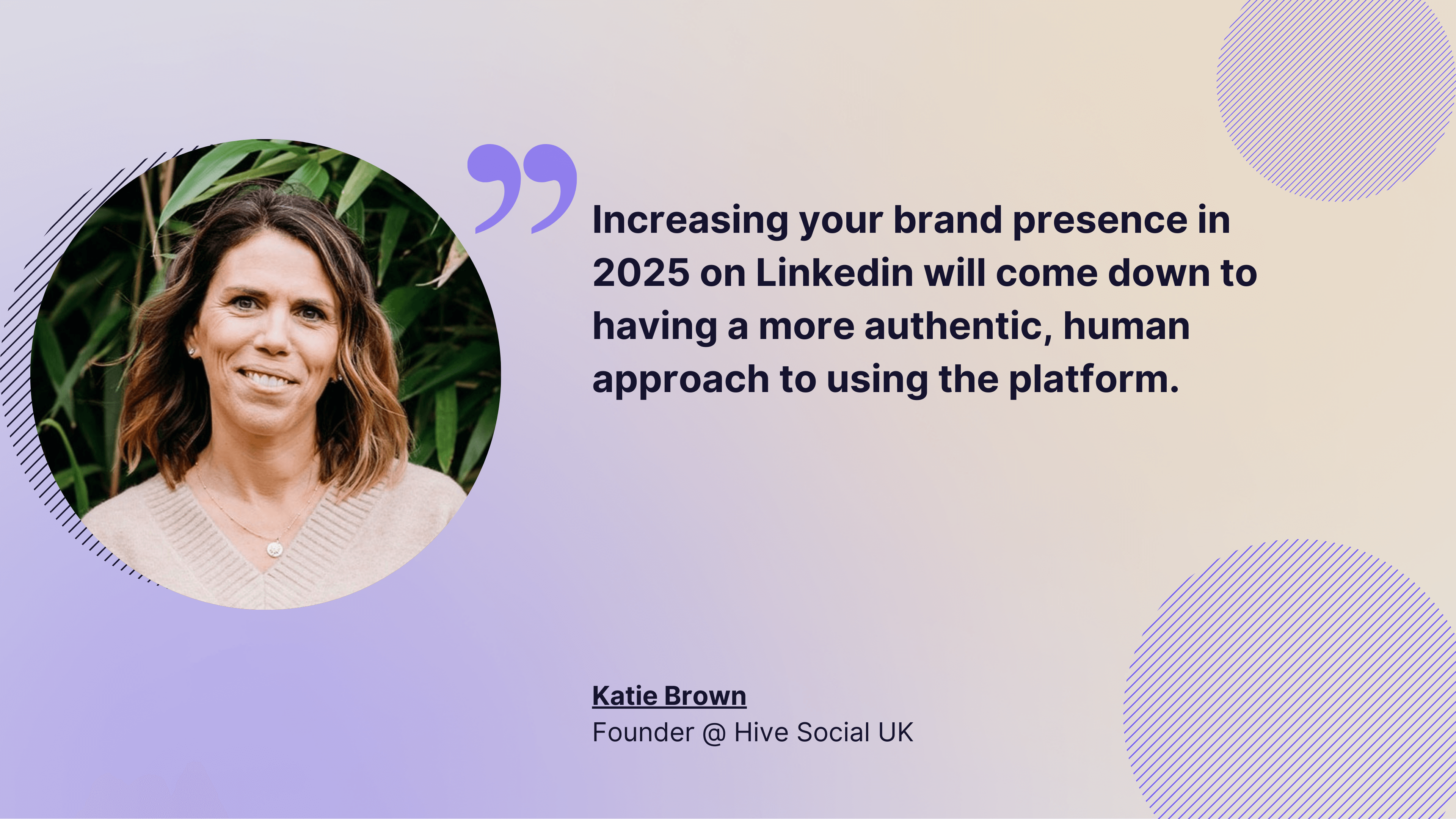
#4. Set performance benchmarks depending on goals
In social media marketing, setting benchmarks is essential for measuring progress, proving impact, and staying focused.
Without clear, realistic expectations, it’s easy to misread success or chase vanity metrics.
Whether your goal is to drive brand awareness (like increasing reach or video views), boost engagement (such as comments, shares, or reactions), or generate leads, each requires different brand metrics and performance thresholds.
The chart below shows how video views vary drastically by audience size—brands with under 5K followers average just 190 views, while those with 100k+ hit over 2.4K.
This kind of insight helps marketers avoid unrealistic comparisons and set goals grounded in where they are now—not where the biggest brands are.
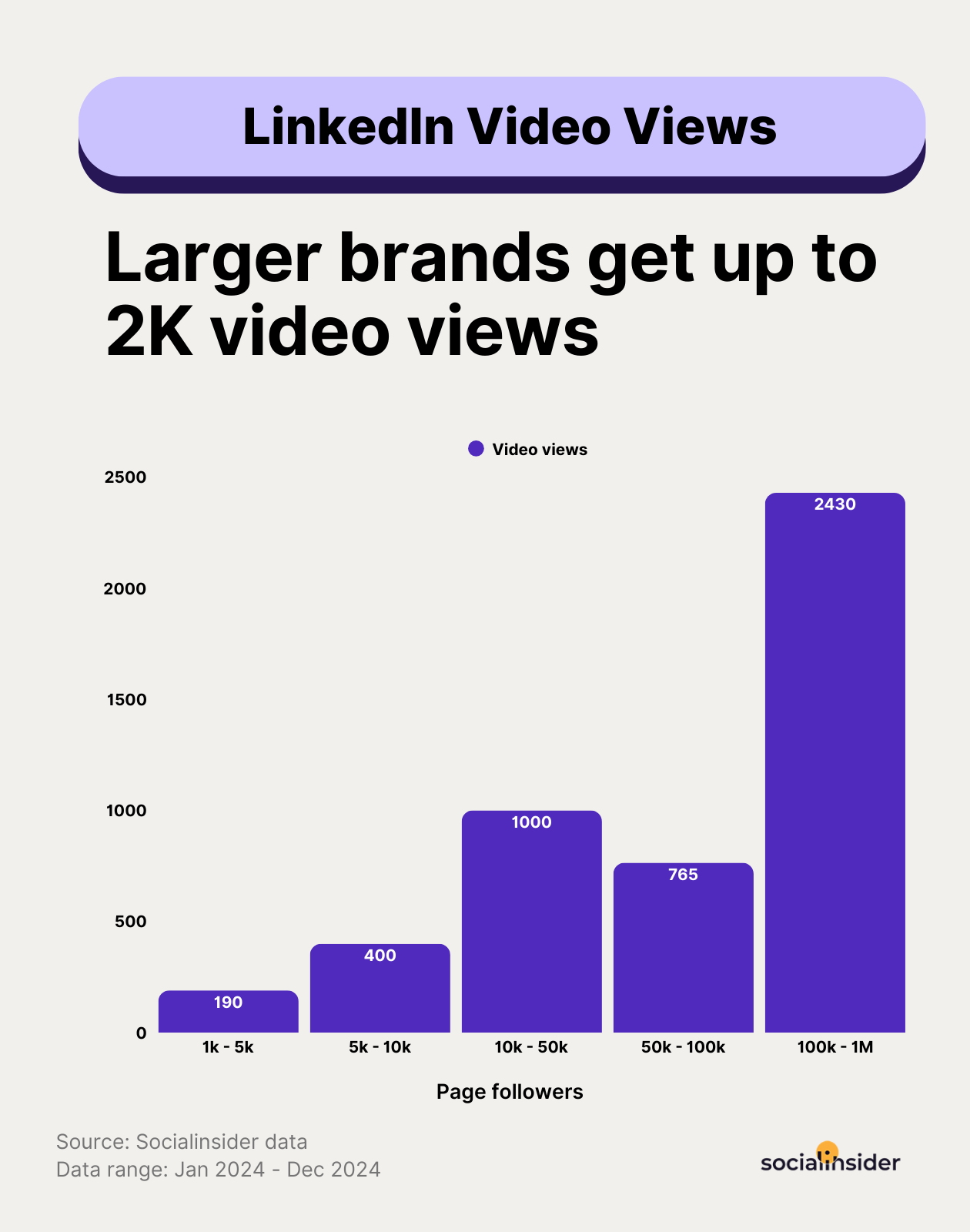
Benchmarks give structure to your strategy, helping you optimize content, report accurately, and scale with confidence.
#5. Have an optimized posting frequency
An effective LinkedIn posting strategy isn’t just about what you post—it’s also about how often you post on social media.
And as the data shows, most brands are keeping it steady—around five image posts and four text posts per month, with a few videos and polls sprinkled in.
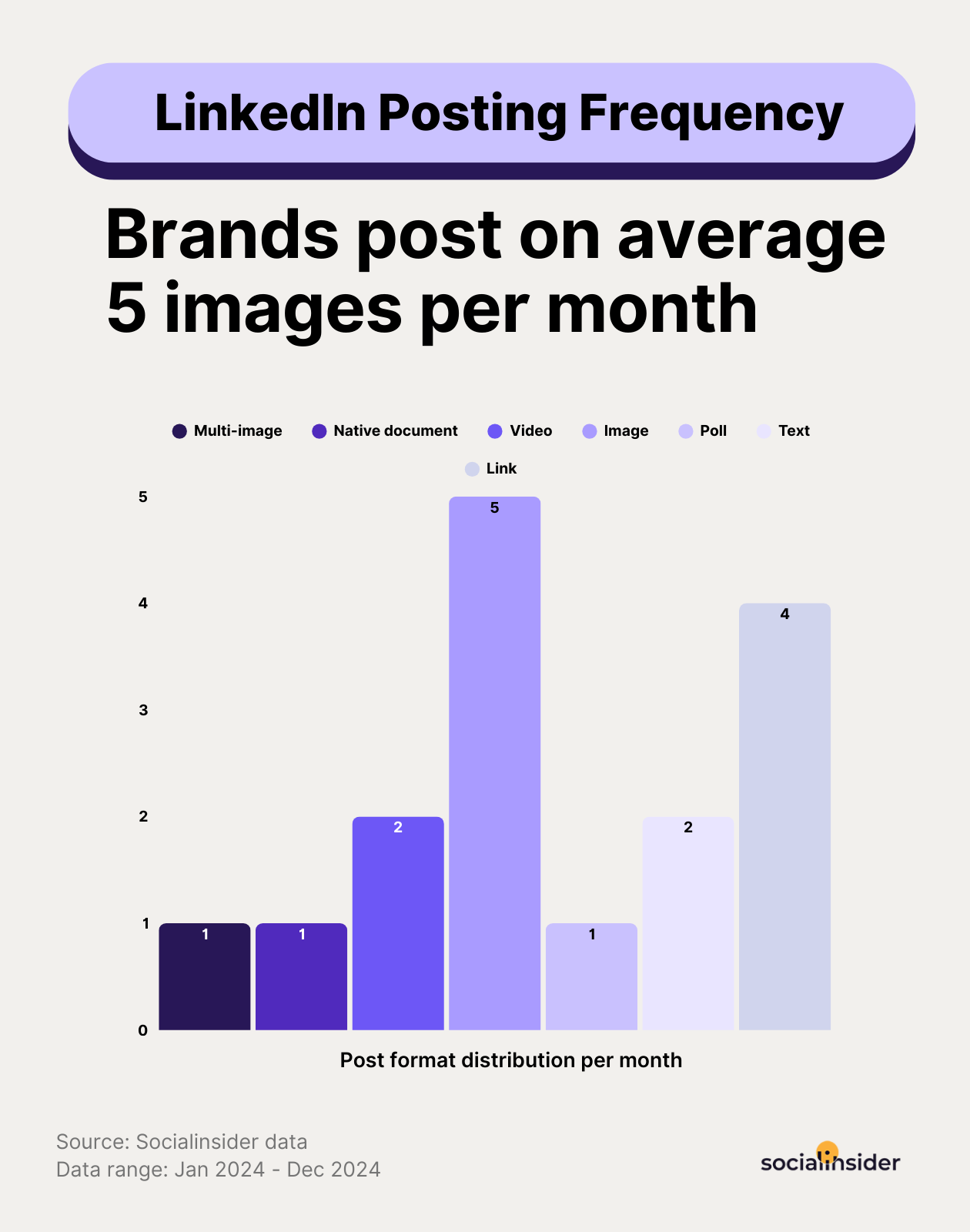
The takeaway?
You don’t need to post daily to stay relevant, but you do need to show up regularly.
Posting too little and you’ll disappear from your audience’s feed; too much, and you risk burnout (yours and theirs).
It’s all about finding that sweet spot where your content stays fresh, your voice is consistent, and the algorithm still knows you’re alive.
#6. Optimize for LinkedIn SEO
LinkedIn isn’t just a social network — it’s an actual search engine.
And yet, most company pages still treat copy like filler instead of fuel.
If you want to show up in relevant searches, get discovered by the right audiences, and grow your organic reach, optimizing for LinkedIn SEO is non-negotiable.
Remember: every word counts toward how the LinkedIn algorithm ranks and recommends your content.
That means being intentional with your page headline, tagline, and About section — using keywords your audience is actively searching for. The same goes for post captions and hashtags: they should reflect how your ideal customers talk, not just how your team does.
So when it comes to growth tips for LinkedIn company pages, this one’s all about long-term discoverability. The right social media optimization makes sure your content gets found and remembered.
#7. Repurpose your most effective content
One of the most overlooked tips for posting on LinkedIn as a company page is learning how to repurpose your strongest content.
If a particular post, stat, or insight resonated once, there's a good chance it will continue to add value in a new format.
For example, we often take key findings from our studies and transform them into carousels, short-form posts, or thought-starters for campaigns.
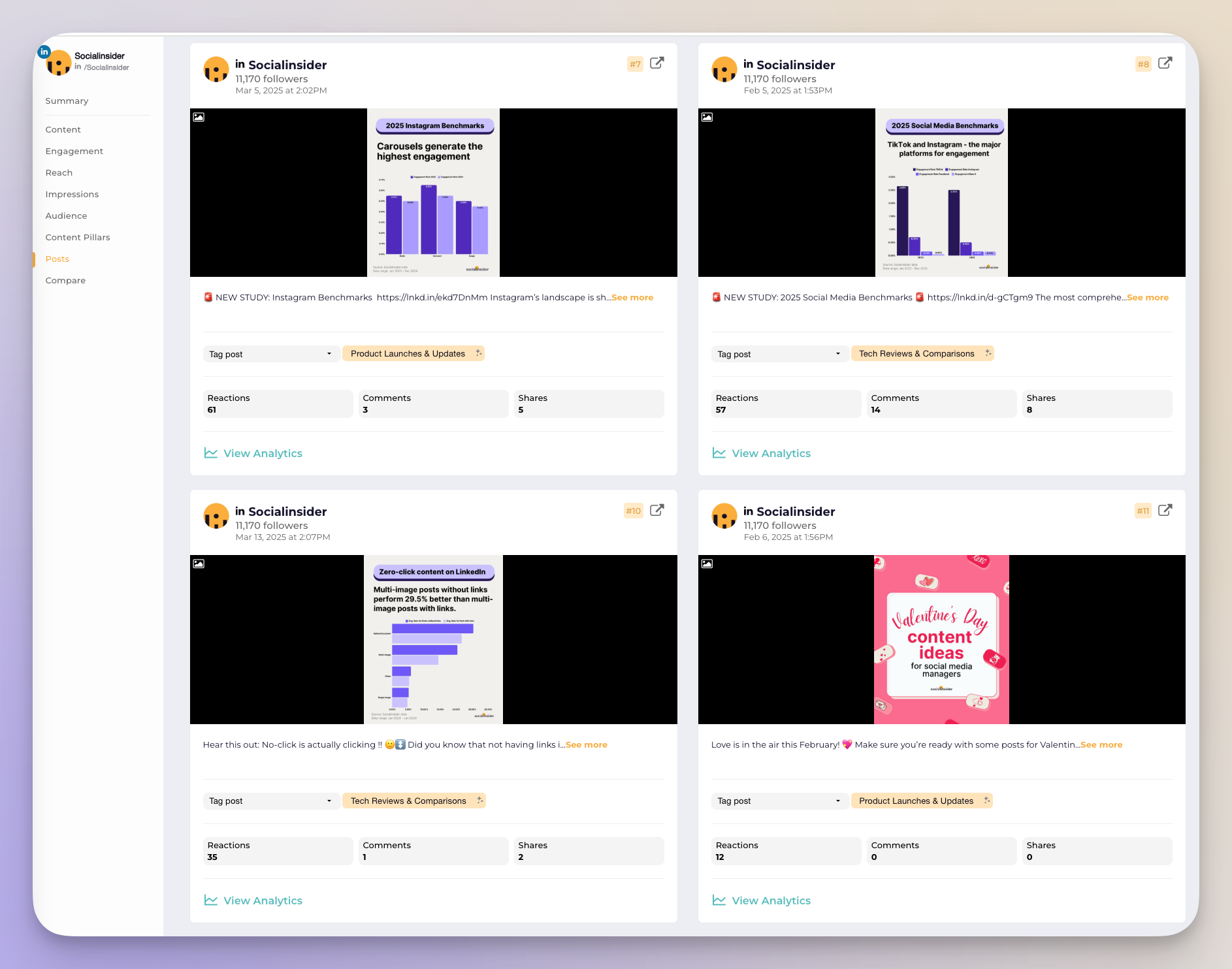
This kind of content repurposing not only extends the lifespan of your best work but also ensures you're showing up consistently with proven value.
Don't let high-performing content gather dust.
Rework it, reframe it, and let it keep working for you.
#8. Leverage analytics for optimization insights
Posting consistently on LinkedIn is important — but optimizing based on performance is what separates a busy feed from an effective one.
If you're not regularly analyzing what types of content resonate most with your audience, you're essentially flying blind.
One of the most underrated LinkedIn best practices is using data to double down on what works and cut what doesn’t.
That’s where Socialinsider’s Content Pillars feature becomes invaluable.
This feature breaks down your social media content strategy by category — helping you evaluate not just how each post performs, but how each type of content contributes to your overall engagement.
In the example shown, just three “Memes, GIFs, Viral Moments” posts drove over 18K engagements and the highest average engagement rate by far, while more frequent content like interactive content delivered lower returns.
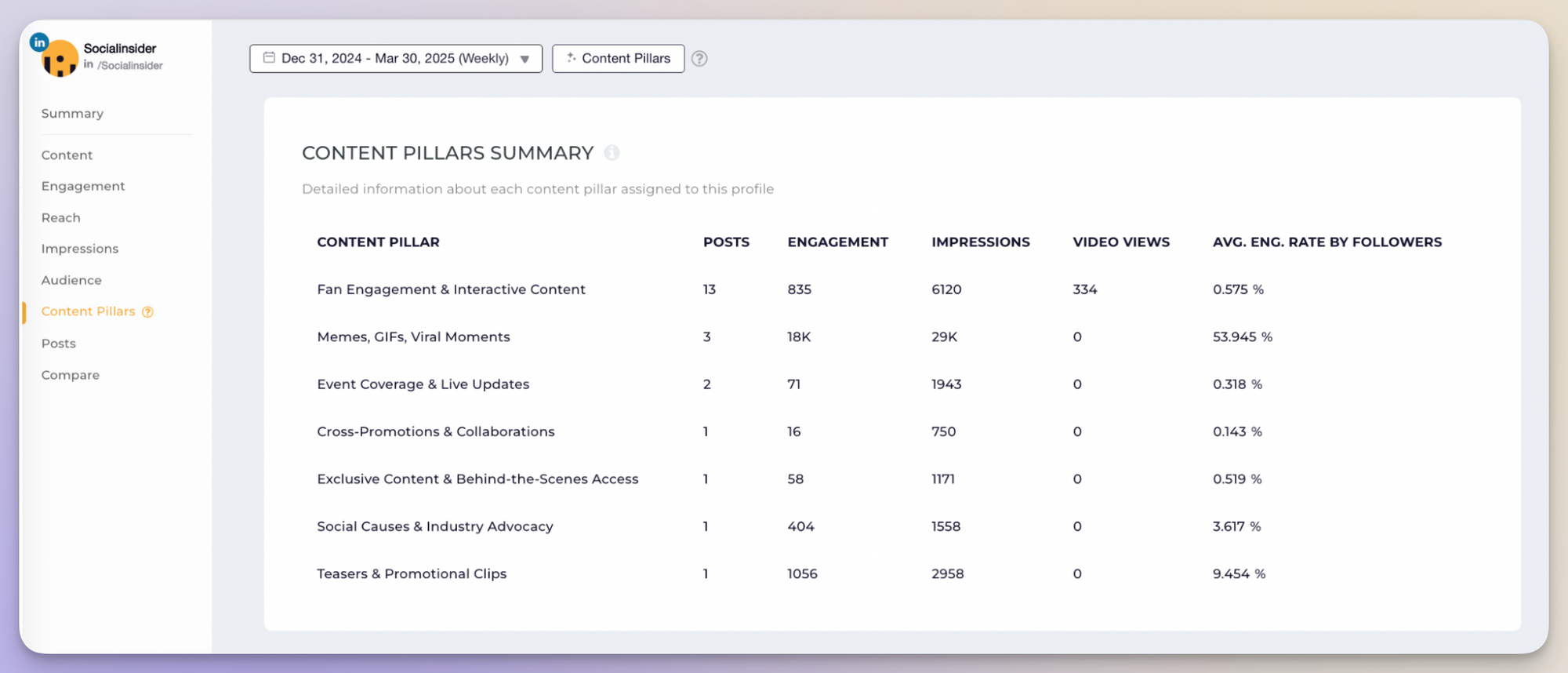
With this level of insight, you’re building smarter content pillars for social media, rooted in actual audience behavior.
#9. Actively engage with your community to spark discussions
Content alone doesn’t build community — conversations do.
That’s why one of the most important social media best practices is showing up after you hit "post."
If your company is only pushing out content without engaging in the dialogue around it, you're treating LinkedIn like a bulletin board instead of the dynamic platform it is.
A savvy social media strategist knows that the real magic often happens in the comments — not just on your own posts, but on others’ as well.
Reply to feedback, ask thoughtful follow-ups, tag relevant voices, and don't be afraid to challenge or build on perspectives. These micro-interactions are what spark momentum and make your brand feel genuinely present.
And don’t sleep on LinkedIn Groups. They’re often overlooked, but they offer a direct line to niche, high-intent communities. It’s one of the rare spaces where showing up as a contributor — not a promoter — can build lasting credibility with the right audience.
In short: engagement isn’t extra. It’s the strategy.
Chasing virality isn't a goal anymore, consumers expect to be prioritised and brands need to focus on connecting with them at a deeper level. — Magali Mas D'Amato, Social Media Consultant

#10. A/B test your LinkedIn ads
Another LinkedIn best practice that often gets overlooked?
A/B testing your LinkedIn ads.
In the world of AB testing social media campaigns, this step is your secret weapon for figuring out what actually works—whether it's the headline, visual, CTA, or audience targeting.
And once you're testing, it helps to know what’s already performing well.
And, as Emilia Korczynska, VP of Marketing at Userpilot and co-founder at ZenABM, points out:
Video and single image ads work best for reaching the broadest (relevant!) audience (ideally with broad targeting based on relevant job titles) at the lowest CPMs. Using text ads, which are basically free, is also a great hack.
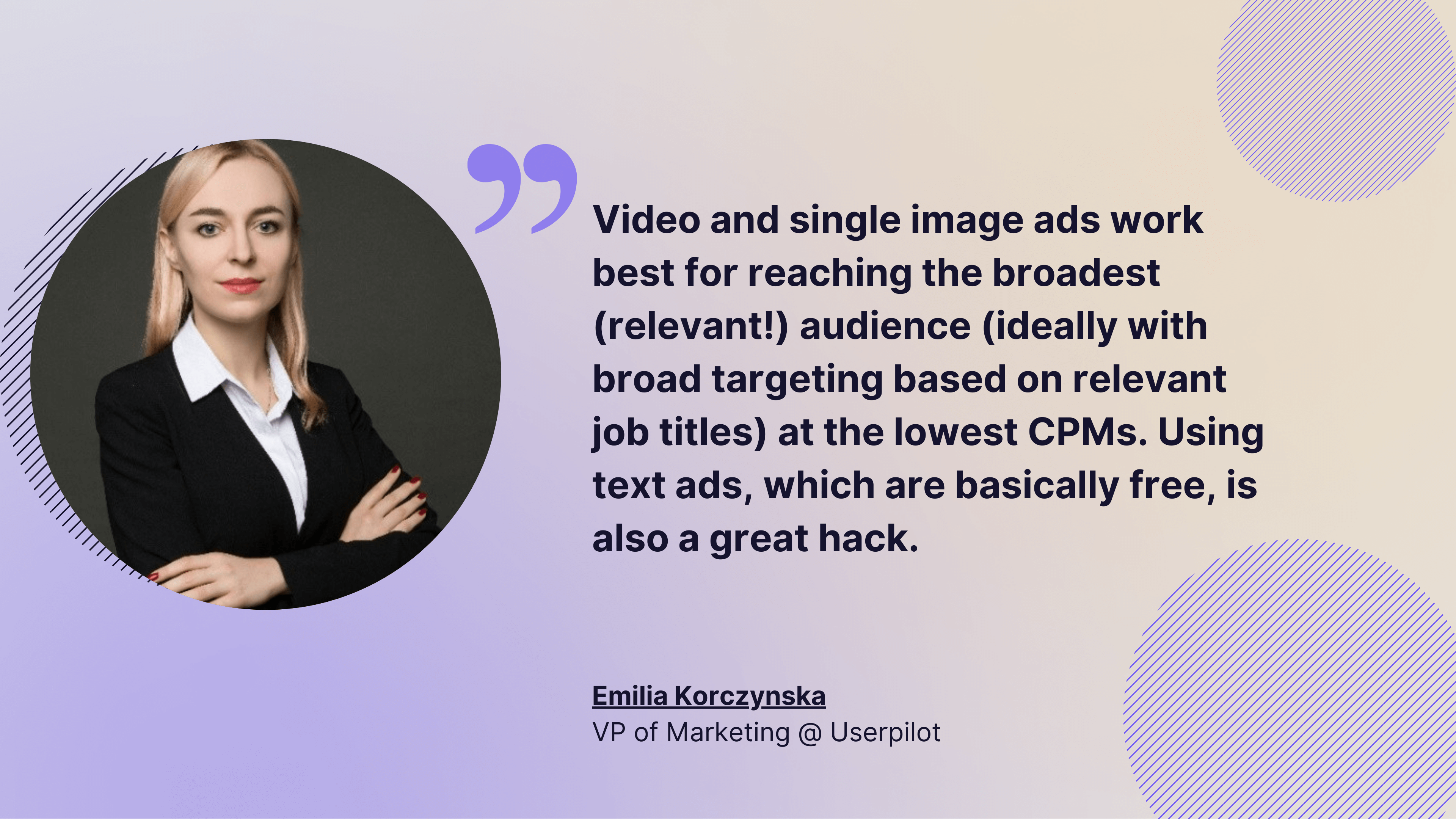
So test, tweak, and repeat—because even small changes can lead to big wins.
Best practices for creating engaging LinkedIn content
So if you're gonna post on LinkedIn, you might as well do it right.
These best practices for posting on LinkedIn will help you show up—and get seen.
#11. Integrate more of the best-performing content formats into your posting calendar
To really stand out, one of the best LinkedIn posting tips is to incorporate high-impact content formats into your strategy.
Our recent social media case study shows that while 30% of brands share images and 28% share links, formats like multi-image posts, native documents, and videos—which tend to get the most engagement—aren’t being used enough.
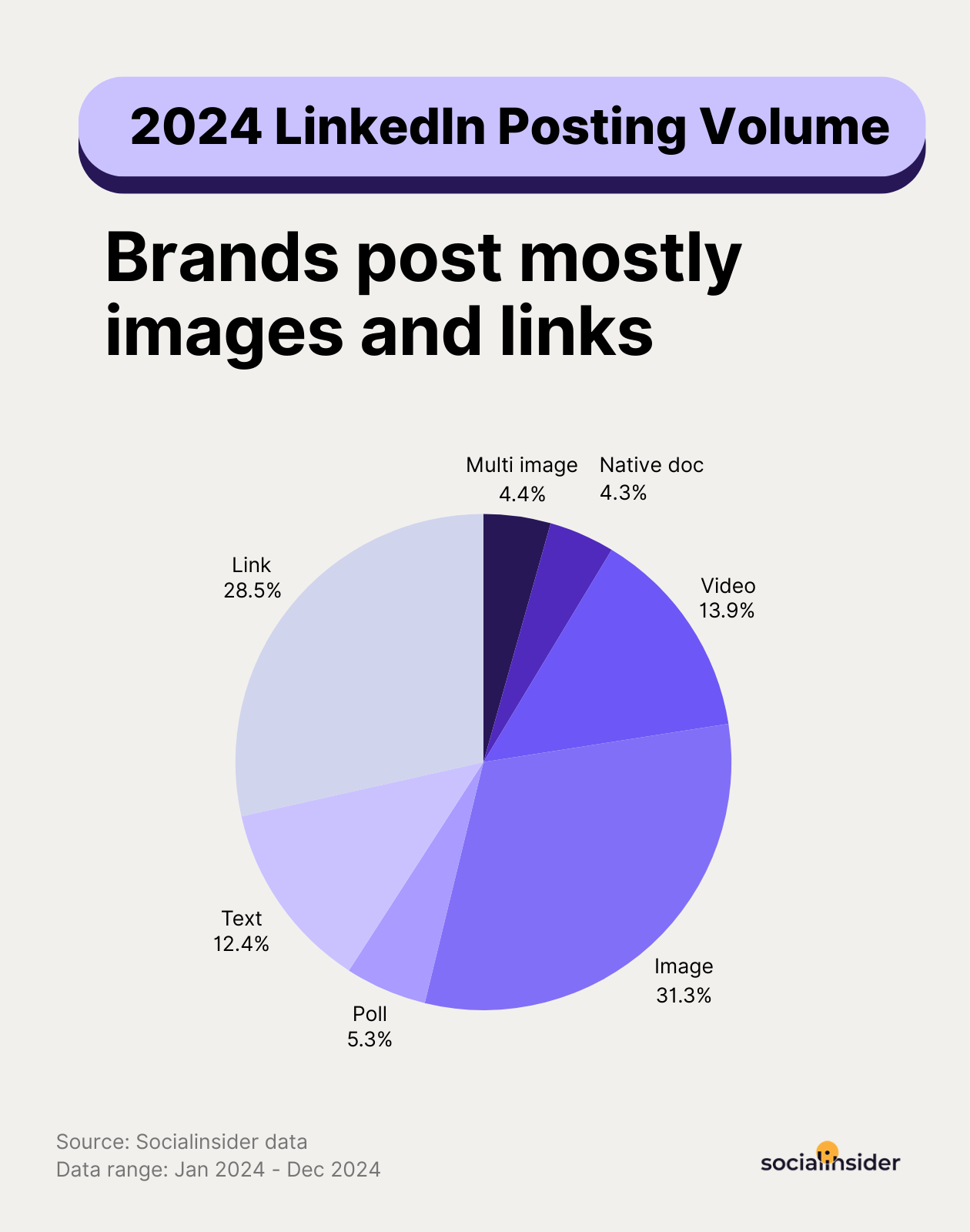
This creates a missed chance to maximize your reach and connect more deeply with your audience.
By weaving these high-impact formats into your calendar, you’re setting yourself up for more effective social media marketing that captures attention and boosts interaction.
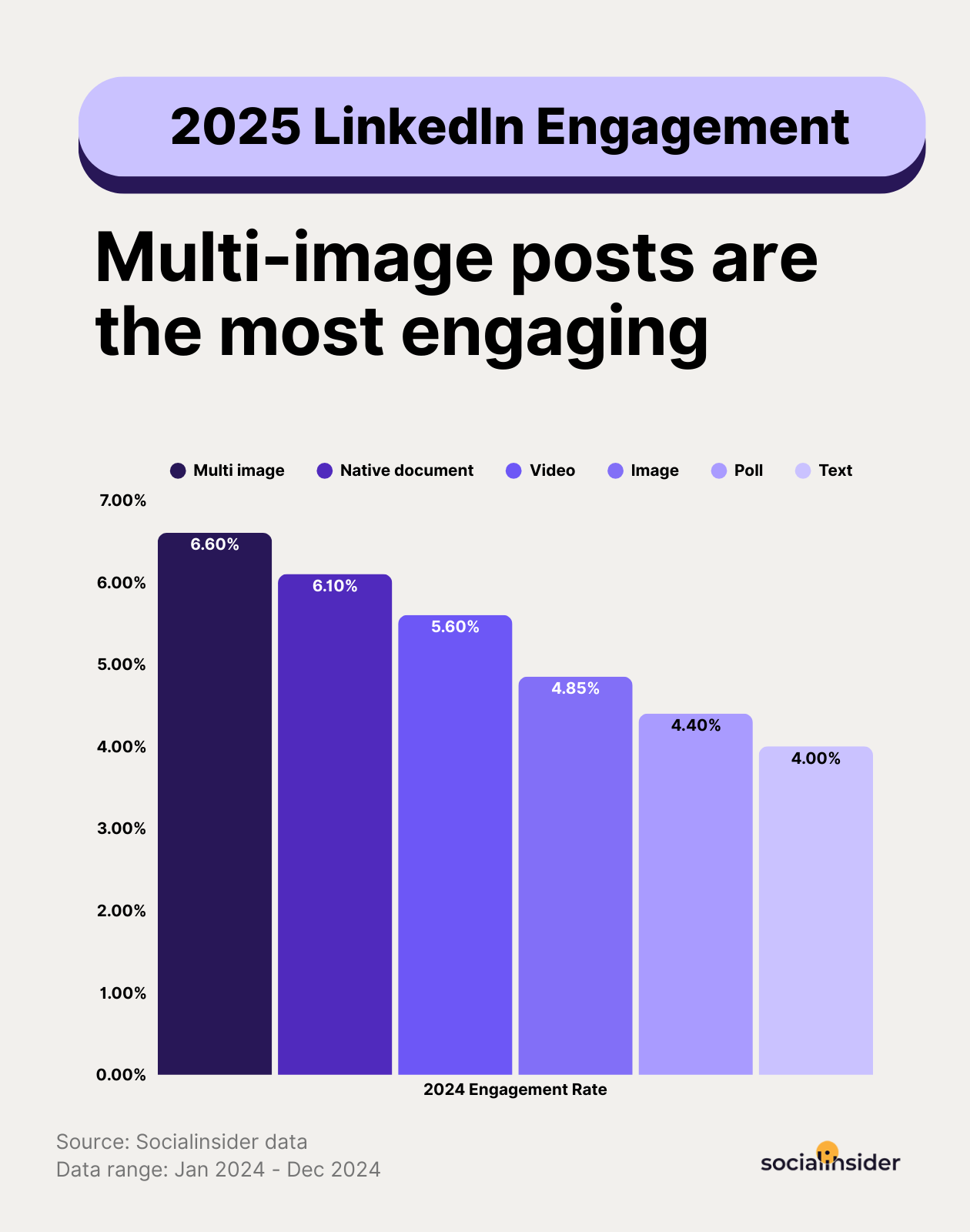
#12. Use polls strategically for audience research
Using polls strategically is one of the most effective LinkedIn posting best practices because they deliver both high engagement and valuable insights.
Polls outperform every other content type in terms of average impressions across all follower tiers, with a dramatic lead for pages between 100K and 1M followers—reaching nearly 30K impressions.
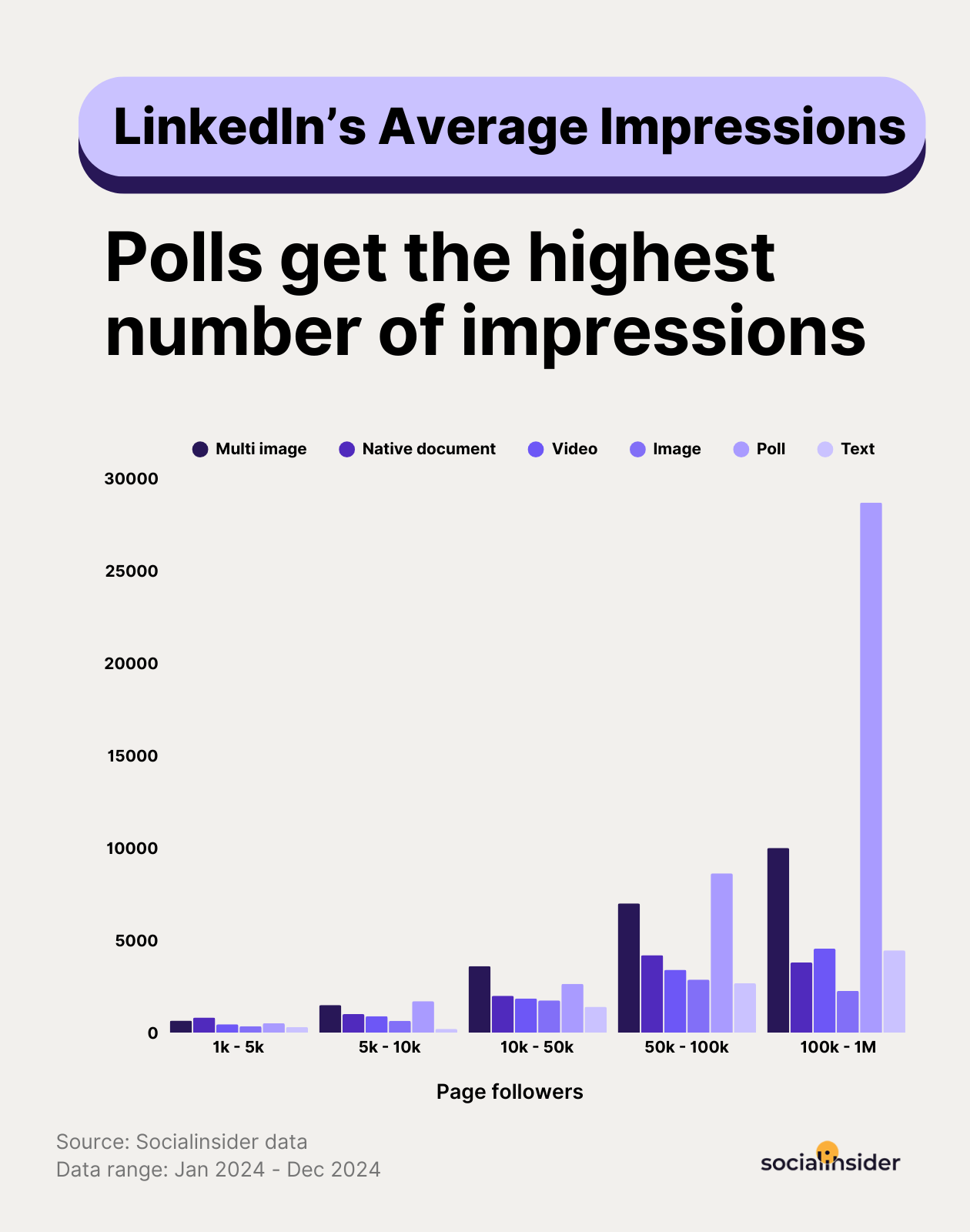
This makes them a powerful tool not just for visibility, but also for social media market research.
By prompting interaction and feedback, polls create a feedback loop that boosts algorithmic reach while providing real-time data on audience preferences, making them a smart, dual-purpose format for brands aiming to grow and learn simultaneously.
#13. Be consistent with video content creation
Be consistent with video content creation—it’s one of the most effective ways to spark conversations and increase engagement.
Data consistently shows that visually-driven content, especially videos are getting more and more traction on LinkedIn, helping brands capture attention and drive interaction. According to our report, this format gained significant increase in the average engagement generated, of 8% over 2024.
With this mind, video marketing ideas should focus on storytelling, sharing insights, or showcasing behind-the-scenes moments, all of which resonate well with audiences.
Moreover, following these social media video tips can help you create content that keeps your brand top of mind, encouraging more meaningful discussions.
Ultimately, this is part of understanding what types of posts work best on LinkedIn and leveraging video to stand out.
#14. Leverage LinkedIn newsletters
One of the biggest social media marketing challenges for brands on LinkedIn is reaching their audience where they are most active and engaged.
This is where leveraging LinkedIn newsletters becomes a game-changer in best practices for LinkedIn marketing.
Newsletters provide an invaluable opportunity to connect with your audience directly in their inbox, ensuring higher visibility and a more personal touch.
For B2B social media marketing, this is particularly effective, as newsletters allow brands to share industry insights, product updates, and thought leadership in a consistent and non-intrusive manner.
Newsletters on LinkedIn are gaining traction with the platform even introducing more newsletter analytics. B2B brands can leverage newsletters to grow their brand presence. — Egline Samoei
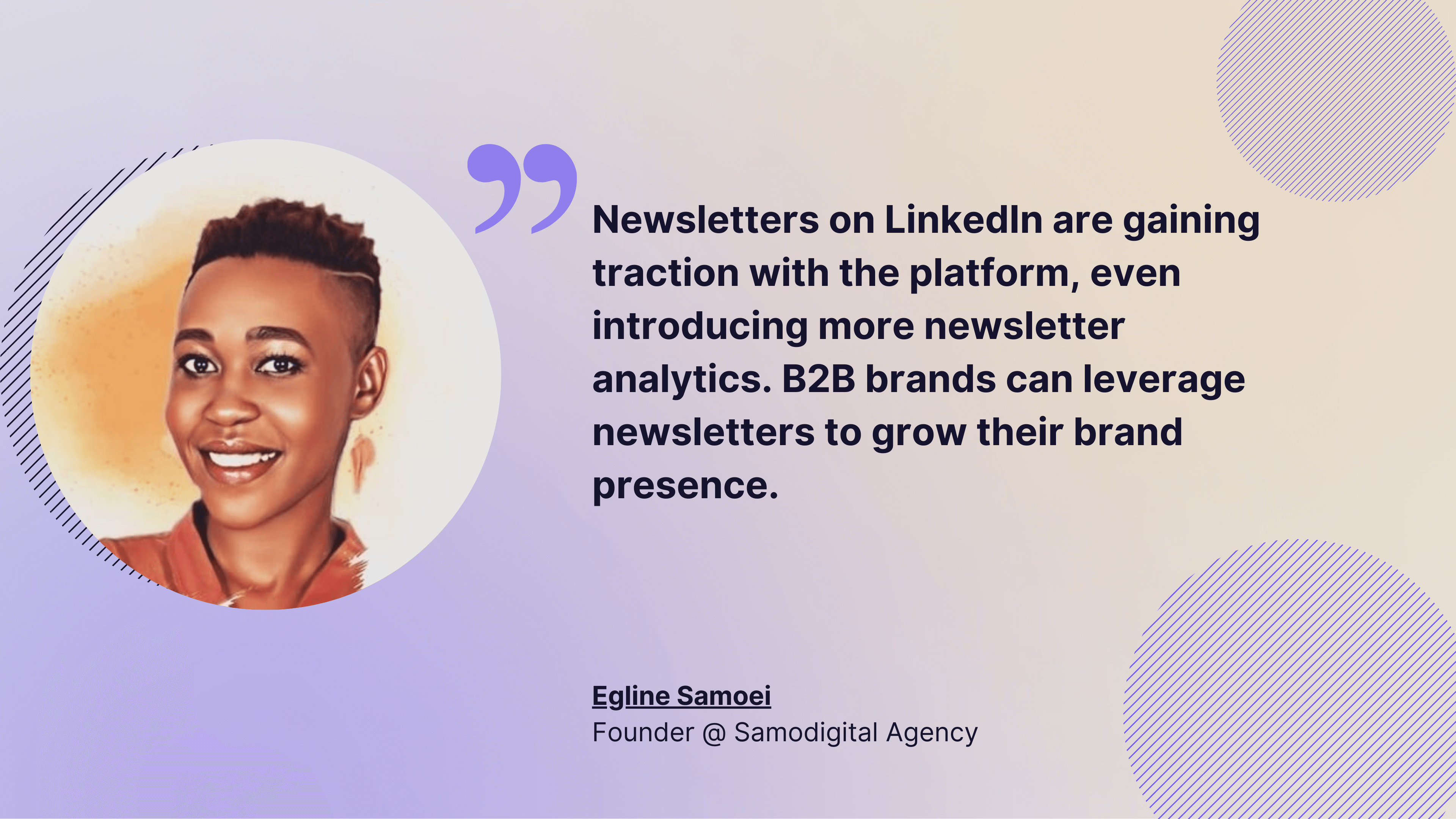
By building a dedicated subscriber base, newsletters not only drive engagement but also improve social media ROI, as they create a lasting, trusted communication channel with your audience.
#15. Measure relevant metrics
When it comes to best practices for LinkedIn posts, measuring social media metrics is key to understanding what’s working and what’s not.
As an example, the LinkedIn follower growth chart shown below clearly demonstrates that small brands (1K-5K followers) experience a whopping 40% increase year-over-year, which outpaces larger accounts.
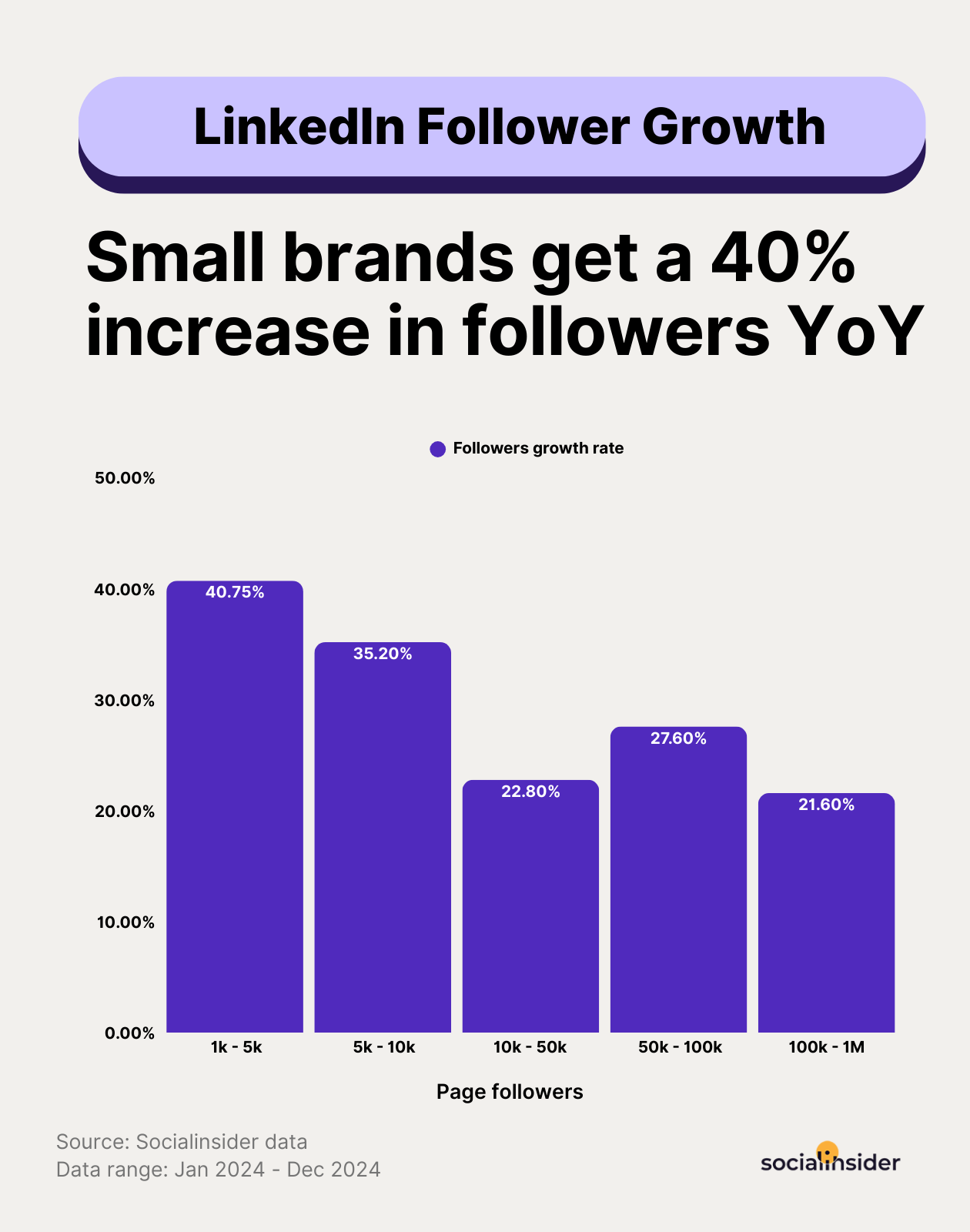
This growth speaks to the effectiveness of your content in reaching new audiences and engaging them.
However, follower growth is just one piece of the puzzle.
For a deeper understanding of your performance, you may also want to look at more granular LinkedIn metrics, like LinkedIn engagement rate, comments, and shares.
These are all powerful indicators of whether your content resonates with your audience.
Moreover, tracking video views and watch time, as shown in the second image, takes this a step further.
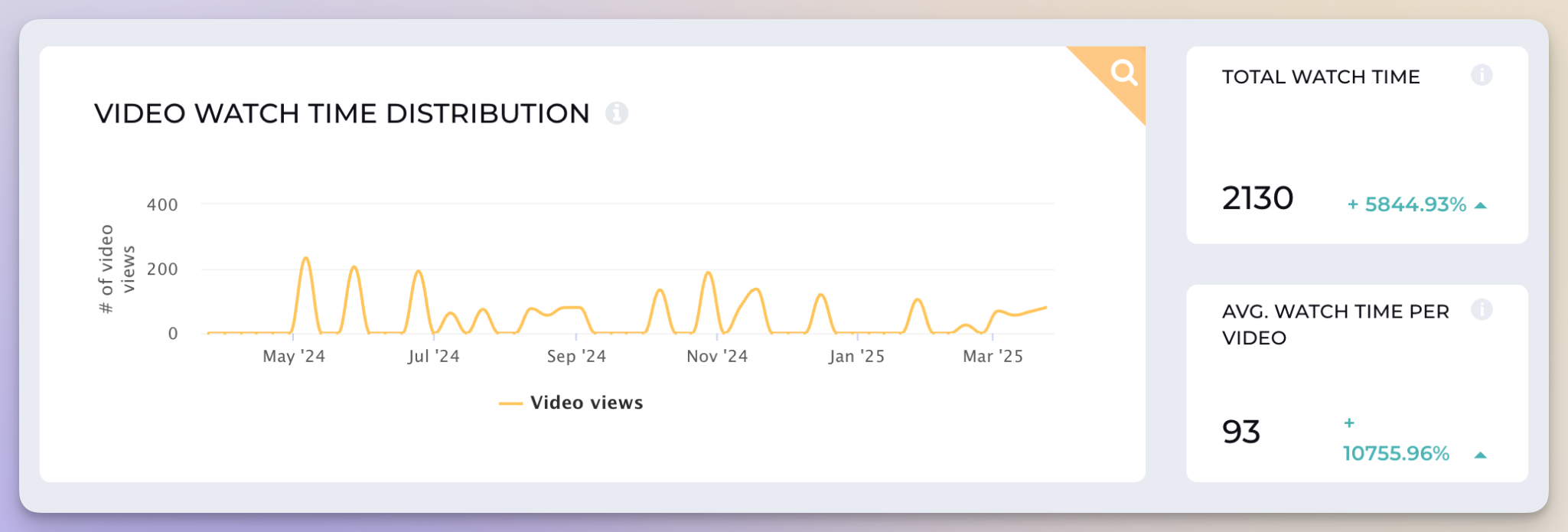
It's not just about getting people to click your video—it's about whether they stick around to watch it.
To truly unlock this potential, leveraging LinkedIn analytics tools is crucial.
These tools allow you to measure social media analytics in a way that’s actionable.
Whether you're tracking Impressions, shares, or comments, you can create a strategy based on hard data instead of guessing what works.
This helps refine your LinkedIn content optimization strategy, ensuring that you're not only attracting followers but also fostering meaningful engagement with your target audience.
In short, effective social media measurement isn’t just about increasing numbers—it’s about making every number count toward building a deeper connection with your audience.
Real-world examples of how different brands are leveraging best practices to improve their strategy
Now that you’ve seen the tips and best practices, let’s dive into real social media marketing examples from brands that are getting it right.
These examples show how smart content analysis and the right social media analytics tools can take a strategy from good to great.
Ahrefs
Ahrefs has nailed the balance between education and engagement on LinkedIn.
Their approach is all about providing real value through content that’s not only informative but easy to digest.
Whether you’re a beginner or a seasoned marketer, their posts often include practical SEO tips you can apply right away. It’s clear they’re building trust by showing they know their stuff.
One standout aspect of their strategy is how they repurpose long-form content from their blog and YouTube channel into bite-sized, scroll-stopping LinkedIn posts.
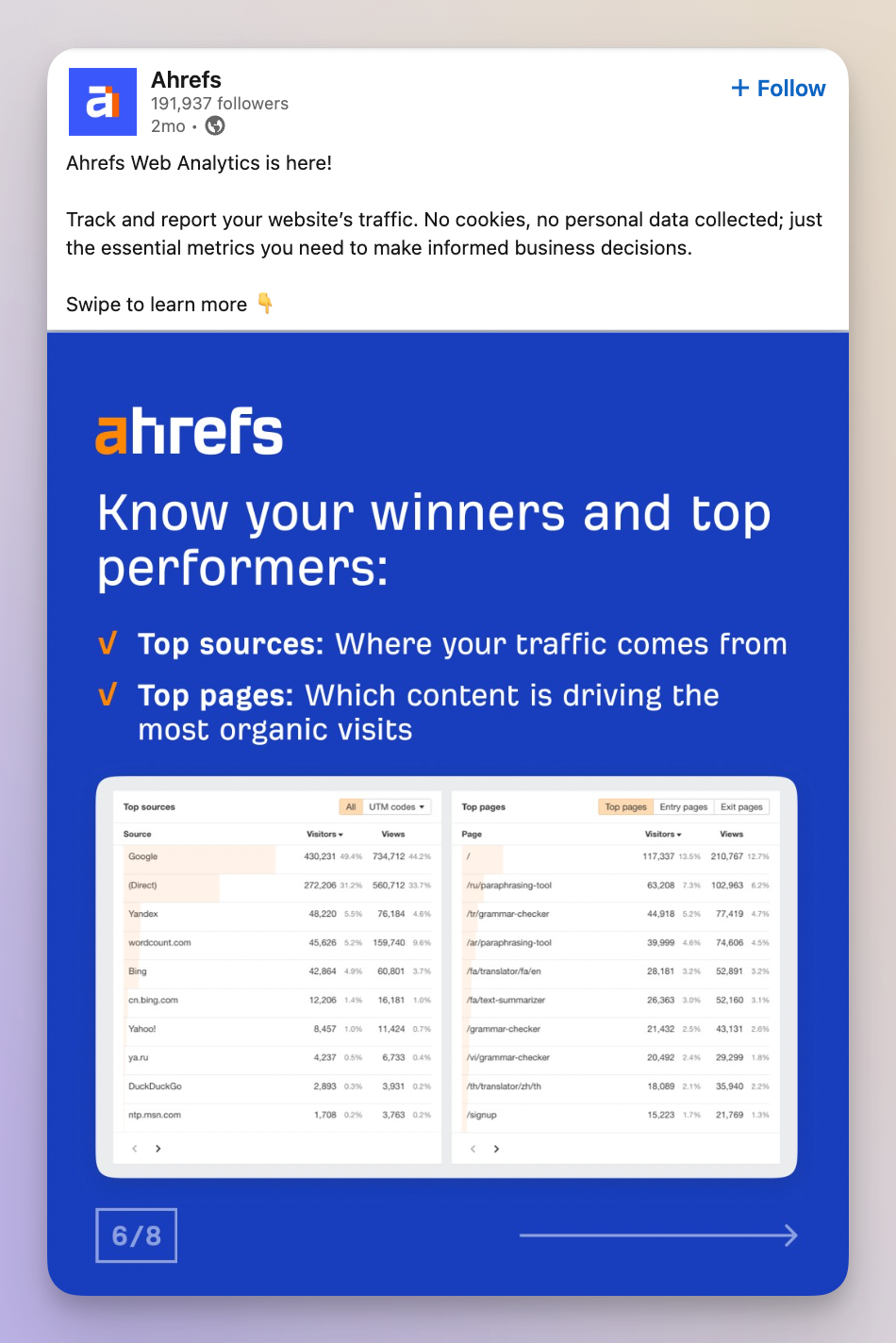
Their carousel formats, often filled with clean visuals and straightforward language, help simplify complex SEO concepts.
Plus, their CMO Tim Soulo adds a strong personal branding layer, sharing behind-the-scenes insights and thought leadership that humanizes the brand and boosts reach.
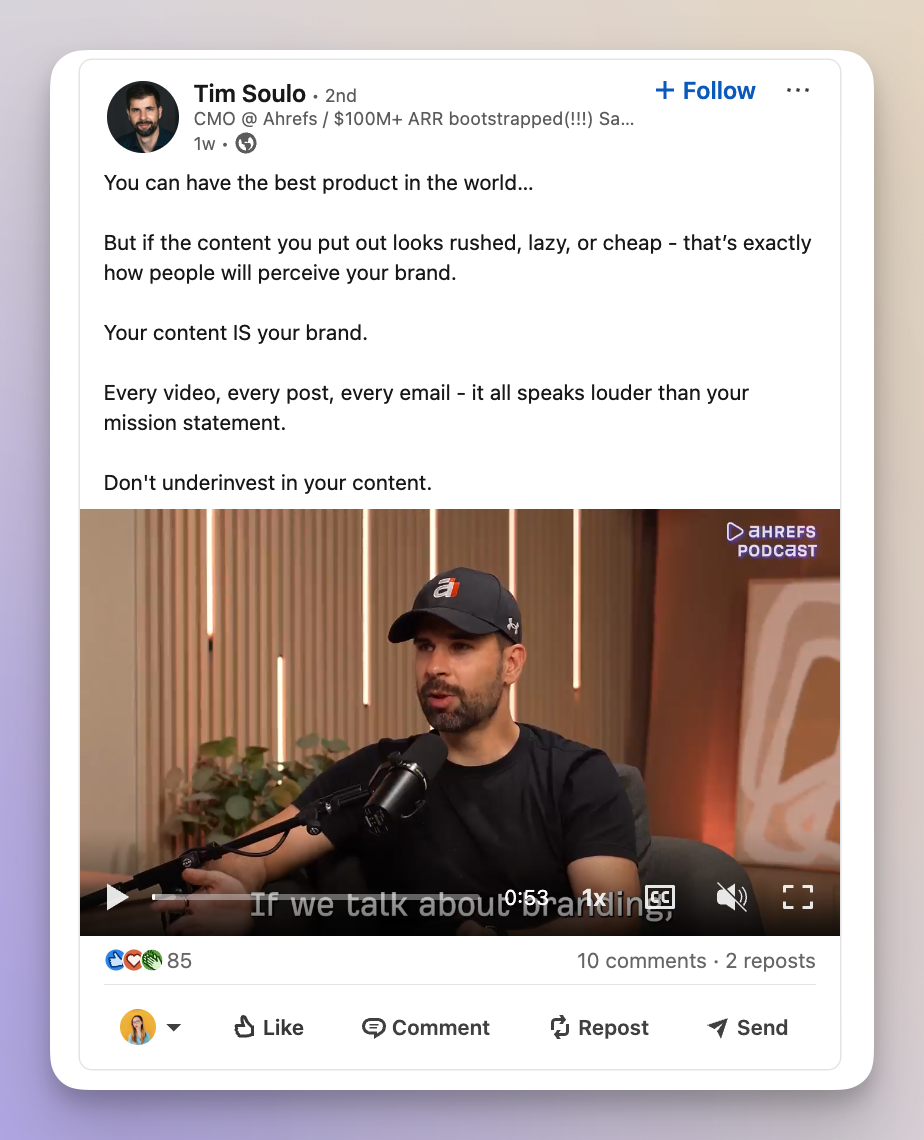
Socialinsider
Another example worth mentioning is, well... Socialinsider.
Here is our secret for turning social media data into scroll-stopping moments.
Don’t want to brag, but our content hits that sweet spot between smart and snackable, mixing original studies, industry updates, and analytics tips with trend-savvy, meme-laced storytelling.
Our approach is— take what could be dry reporting and inject it with personality—highlighting real customer struggles in ways that actually make you want to read about data gaps and growth charts.
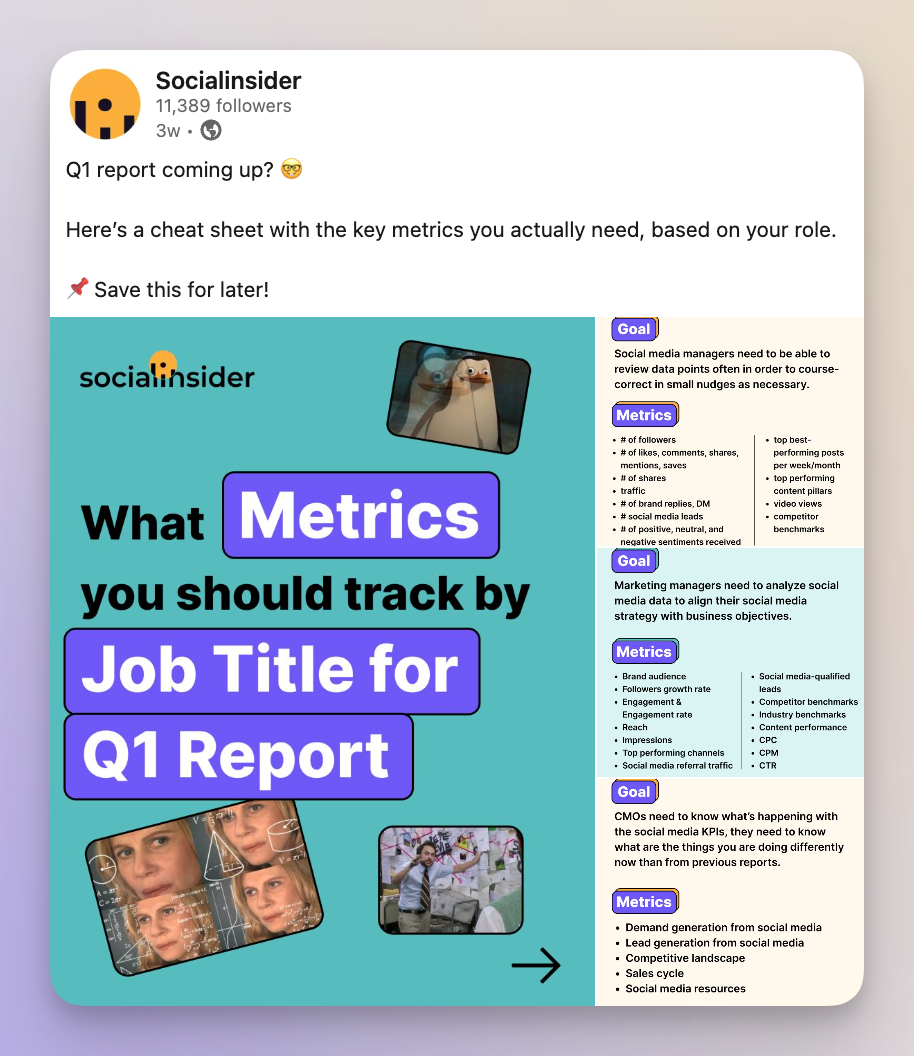
We also play the distribution game like pros.
By tagging contributors and collaborators in our posts, we're not just sharing insights—we're starting conversations across wider networks.
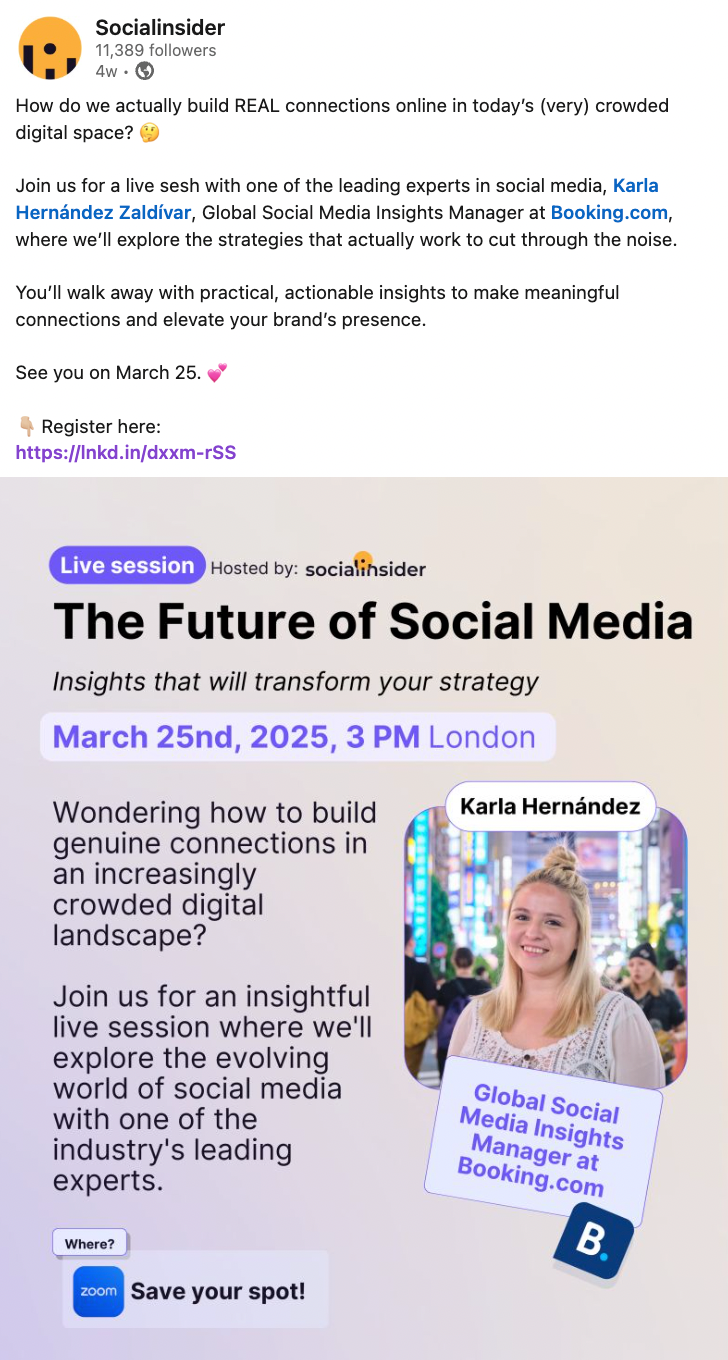
And at the center of it all is Adina Jipa, co-founder and CMO, who uses her personal LinkedIn as a megaphone for the brand.
Her voice gives the brand edge and heart.
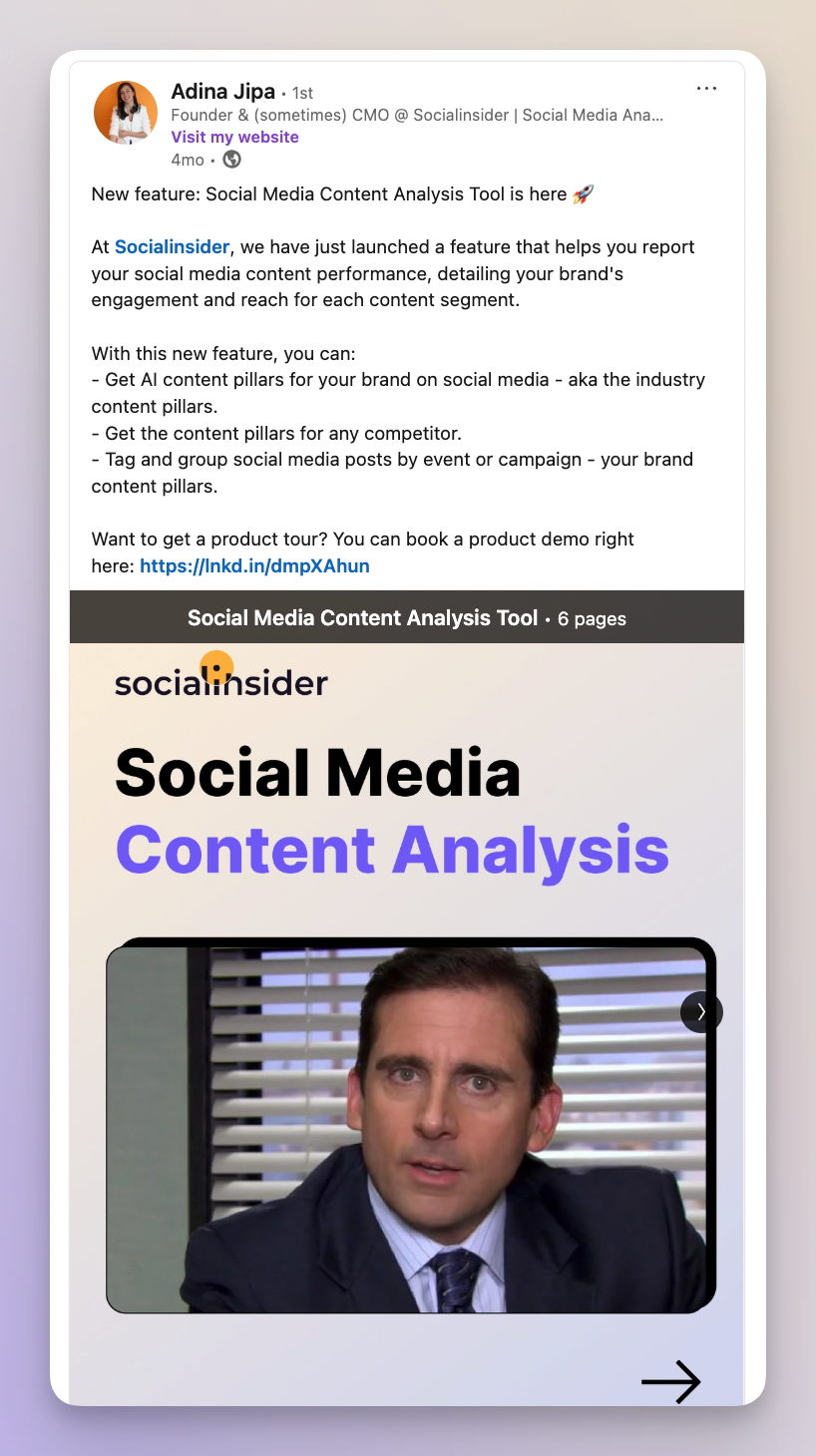
Visually, we aim for our posts to be crisp and purpose-built. Think clean charts, clever overlays, and a consistent design language that makes analytics feel less like spreadsheets and more like a well-timed mic drop.
Final thoughts
As you’ve probably figured already, LinkedIn isn’t just for job hunters—it’s a secret weapon for sharp social media marketing. But only if you know the rules.
Hopefully, these LinkedIn best practices will turn ghost town feeds into high-traffic hubs, transforming your profile from forgettable to follow-worthy.
Analyze your competitors in seconds
Track & analyze your competitors and get top social media metrics and more!
You might also like
Improve your social media strategy with Socialinsider!
Use in-depth data to measure your social accounts’ performance, analyze competitors, and gain insights to improve your strategy.



